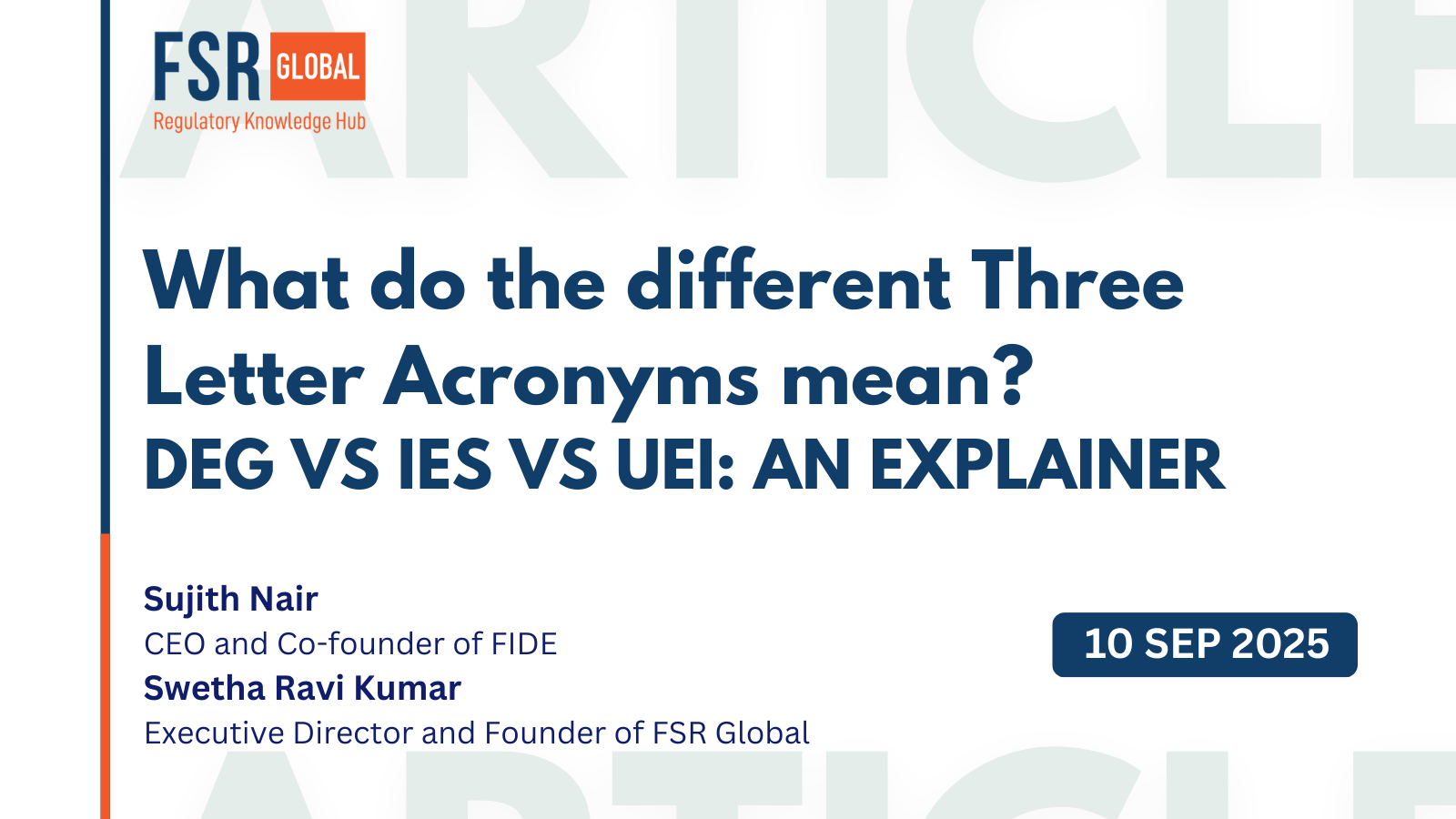Article
What do the different Three Letter Acronyms mean?
DEG vs IES vs UEI: An Explainer

Sujith Nair, CEO and Co-founder of FIDE;
Swetha Ravi Kumar, Executive Director and Founder of FSR Global
Article
Sept. 10, 2025
At a Glance
- Digital Energy Grid (DEG) → The vision and framework for a universal digital infrastructure for energy- coordinating energy, information, and transaction flows across interoperable ecosystems. It is broad-based, globally relevant, and adaptable to any country’s context.
- India Energy Stack (IES) → India’s policy-driven framework for realising the universal digital infrastructure vision via a DPI blueprint and rollout plan tailored to India’s needs, with standards, governance, and an implementation pathway for current and future use cases – with public stewardship, broad ecosystem participation and converges with the DEG vision.
- Unified Energy Interface (UEI) → A community-driven manifestation of DEG vision: an open transaction network used for specific energy services, built by a coalition of utilities, startups, academia, and public actors.
Digital Energy Grid (DEG) | The north star
- Definition: A general-purpose vision and reference framework for a universal digital infrastructure that enables interoperable energy systems.
- Purpose: To articulate the necessity and specify the minimal building blocks- universal identity, machine-readable data, and verifiable/ portable records- so assets, stakeholders, and markets can interoperate with trust, aligning data, energy, and transaction flows.
- Scope: Global and context-adaptable in nature, focusing on principle-setting (identity standards, data schemas, and trust/verification) technology- and market-neutral, and not bound to any single country or stack.
- Outcome: A guiding framework that informs national stacks and market designs, offering a common language that lets existing systems compose.
India Energy Stack (IES) | The national-scale infrastructure and roadmap
- Definition: India’s Digital Public Infrastructure (DPI) initiative for energy, led by public policy with a ‘whole of ecosystem’ approach.
- Scope: The framework, components, and specifications that India will establish, including registries, data exchange mechanisms, data governance, data security and compliance protocols, to help integrate data (mapping), services (verify, validate), market solutions and applications (facilitate) seamlessly.
- Approach: The implementation strategy, encompassing reference data architecture and designs, standards and specifications, pilot projects through sandboxes, conformance assessments, scaling efforts, and regulatory pathways – with public stewardship, broad ecosystem participation and converges with the DEG vision.
- Outcome: Interoperability across India’s power ecosystem (DISCOMs, TRANSCOs, GENCOs, market operators, consumers, etc.), and geographies, thereby accelerating innovation in the Indian context- while offering a model others may adapt.
Unified Energy Interface (UEI) | A transactive network
- Definition: An open, community manifestation of DEG principles (and consistent with IES) in the form of an open network for discovery, booking, fulfilment, and settlement of different energy services across the chain.
- Role: A tangible mechanism for transactional interoperability across use cases- EV charging, rooftop-solar services, peer-to-peer trading, demand flexibility- developed by a coalition of utilities, startups, think-tanks, and academia.
- Benefit: Plug-and-play participation across apps, devices, and utilities- lowering integration costs and enabling market creation today, while progressively aligning with IES rails as the national stack formalises.
One-Line Analogies
DEG: “We need number plates, traffic rules, and trusted road signs globally.”
IES: “Here’s India’s highway blueprint, standards, specifications, contracts, and construction plan.”
UEI: “Community-operated toll lanes that already accept FASTag- running today on shared rules and plugging into the national highway stack as it formalises.”
IES Background
The Ministry of Power (MoP) is reimagining the digital backbone for India’s Power sector by creating a Digital Public Infrastructure (DPI) for the Power sector through an India Energy Stack. Traditionally, data silos, fragmented systems, and disparate protocols have hampered cohesive decision-making and innovation in the energy sector. The India Energy Stack (IES) is envisioned as a national digital infrastructure that provides a standardised, interoperable, modular, and secure digital framework to manage, monitor, and innovate across the energy ecosystem.
The concept and roadmap for the India Energy Stack (IES) was first proposed by FSR Global, building on research conducted under the Smart Grid Observatory (SGO) in partnership with the National Smart Grid Mission (NSGM) and the EU-India Clean Energy and Climate Partnership. This effort convened more than 50 global experts to shape the initial vision over a span of 3 years.
Today, the idea of the India Energy Stack is being advanced under the leadership of the Ministry of Power, with REC serving as the Nodal Agency and FSR Global providing strategic support as Knowledge Partner and Secretariat.
The India Energy Stack (IES) will be implemented in two phases by the MoP. In the first phase, a blueprint and detailed roadmap will be developed, informed by demo projects with pilot discoms to test and shape the design of the IES. The second phase will focus on a nationwide rollout.
To contribute and be a part of the IES movement, write to us with your thoughts at ies[dot]secretariat[at]fsrglobal[dot]org
Unified Energy Interface (UEI) Background
UEI’s journey is deliberately bottom-up: a coalition of utilities, startups, academics, and public institutions first solved practical interop problems in the field (specifically started with EV charging transactions), then generalised those learnings into an open transaction network others could reuse. Today UEI manifests almost 18,000 daily transactions across multitudes of use-cases.
From the earliest integrations to multi-party pilots, the emphasis has been on fast, low-cost onboarding, adapters to existing systems, and a developer-first manifestation. The objective is to serve as both living laboratory and production rail- proving new market interactions (discovery, contracting, fulfilment, settlement), lowering integration friction and interaction costs leading to expanded market base for participants of all sizes, and feeding evidence back into formal stack design. As national frameworks mature, UEI’s governance and conformance can progressively align with them, while retaining the agility of a community-run effort to keep experimenting, documenting, and scaling what works.
